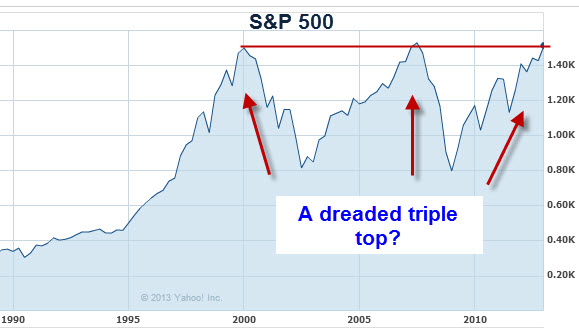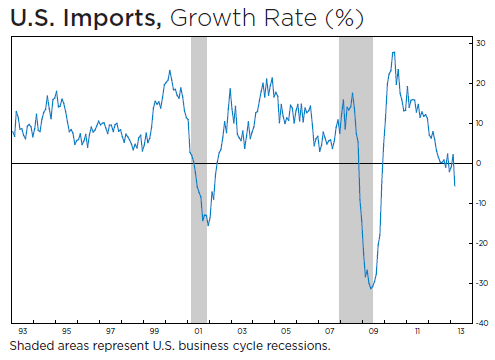Today's Market
 by Dr Invest
by Dr Invest
Over the past months, the market continues an upward climb. One would think that we are setting on an economic rocket. While the GDP is expected to grow barely over 2%, growth projections over the next 10 years for the GDP is estimated at only around 1.8%.
The problem is that a double digit growth in commodities in 2013 doesn't reflect the actual weakness in the economy. Analysts have acknowledged that the economy is weak and will be even weaker in 2014 because of increased taxes from Obamacare. Adding to the increase in taxes is the requirement that families purchase medical insurance. Even with subsidies, the poor will see a drain on their total income as they pay something for their health insurance. This means less money per household for consumables. This is why the projection is decreased for overall GDP. When you don't have extra money to spend, you put off buying a car, a washing machine, a television, a computer...etc. The economy never heats up... it can't heat up, because the economy is stagnant.
The greatest fear is that we will return to the STAGFLATION of the 70s. Government stimulus pushes prices higher, but taxation and debt bring recession as people have less to spend. Experimental Economics will result in even larger bubbles and the outcome will result is great sorrow. The poor will become poorer, the middle class will slip into poverty, and the wealthy will become less wealthy. Because people are earning less, state and national government will collect less taxes and pressure will be put upon politicians to tax the wealthy even more.
There is no significant growth in the economy, but rather a significant slowing. Stocks are being priced in at some FUTURE value, but when it is clear that that "future value" cannot be achieve, there will be a sudden sickening sell-off.
Knowing that the economy is deteriorating, I couldn't risk the potential losses that are sure to come. I continue to hold some bond positions and a few stock positions but believe that a downtrend will begin in the first six months of 2014. As I have already said, the economy has deteriorated over the past two years. The government has set new guidelines for the CALCULATION OF INFLATION, the CALCULATION OF UNEMPLOYMENT, and the CALCULATION OF GDP that makes the economy appear more robust that it actually is. Everyone knows that this is simply a "fudging of numbers" and "creative accounting". If you or I did the same kind of accounting, we would be immediately charged for criminal conduct.
SUGGESTIONS
If you are already in a stock position, keep a stop-sell on your positions. For example, if you have seen an increase of 15%, a stop-loss set at 10% might be acceptable for 2013. If the new Fed Chairman keeps stimulating, your stocks could rise even further until a collapse in the market is achieved. If you do not hold stock positions, don't buy them now. Stay away! Stocks are overvalued and overbought. Go buy a good certificate of deposit until the storm passes.
The above information is for entertainment purposes only and should not be used as investment advice.
Over the past months, the market continues an upward climb. One would think that we are setting on an economic rocket. While the GDP is expected to grow barely over 2%, growth projections over the next 10 years for the GDP is estimated at only around 1.8%.
The problem is that a double digit growth in commodities in 2013 doesn't reflect the actual weakness in the economy. Analysts have acknowledged that the economy is weak and will be even weaker in 2014 because of increased taxes from Obamacare. Adding to the increase in taxes is the requirement that families purchase medical insurance. Even with subsidies, the poor will see a drain on their total income as they pay something for their health insurance. This means less money per household for consumables. This is why the projection is decreased for overall GDP. When you don't have extra money to spend, you put off buying a car, a washing machine, a television, a computer...etc. The economy never heats up... it can't heat up, because the economy is stagnant.
The greatest fear is that we will return to the STAGFLATION of the 70s. Government stimulus pushes prices higher, but taxation and debt bring recession as people have less to spend. Experimental Economics will result in even larger bubbles and the outcome will result is great sorrow. The poor will become poorer, the middle class will slip into poverty, and the wealthy will become less wealthy. Because people are earning less, state and national government will collect less taxes and pressure will be put upon politicians to tax the wealthy even more.
There is no significant growth in the economy, but rather a significant slowing. Stocks are being priced in at some FUTURE value, but when it is clear that that "future value" cannot be achieve, there will be a sudden sickening sell-off.
Knowing that the economy is deteriorating, I couldn't risk the potential losses that are sure to come. I continue to hold some bond positions and a few stock positions but believe that a downtrend will begin in the first six months of 2014. As I have already said, the economy has deteriorated over the past two years. The government has set new guidelines for the CALCULATION OF INFLATION, the CALCULATION OF UNEMPLOYMENT, and the CALCULATION OF GDP that makes the economy appear more robust that it actually is. Everyone knows that this is simply a "fudging of numbers" and "creative accounting". If you or I did the same kind of accounting, we would be immediately charged for criminal conduct.
SUGGESTIONS
If you are already in a stock position, keep a stop-sell on your positions. For example, if you have seen an increase of 15%, a stop-loss set at 10% might be acceptable for 2013. If the new Fed Chairman keeps stimulating, your stocks could rise even further until a collapse in the market is achieved. If you do not hold stock positions, don't buy them now. Stay away! Stocks are overvalued and overbought. Go buy a good certificate of deposit until the storm passes.
The above information is for entertainment purposes only and should not be used as investment advice.



















